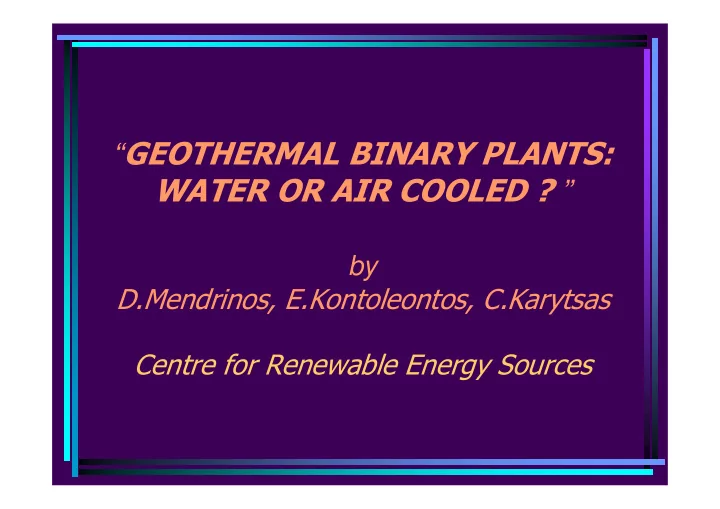

“ �������������������������� ��������������������� ” by ��������������������������������������� �����������������������������������
Geothermal Power Plants • Back pressure flash plants • Condensing flash plants • Binary plants
Cooling Options • (water cooled condensers) & (surface water) • (water cooled condensers) & (wet type cooling towers) • (air cooled condensers) & (dry type cooling towers �
������ ���������� − Tg Tc = n Tg “ Tg ”: geothermal source temperature, ° K • " Tc ”: cooling water temperature, ° K •
Turbine Efficiency ( ) = g ⋅ = ⋅ ⋅ − N n w w n m H H t s o ( ) ⋅ ⋅ − n n H H N g t s o = = n ⋅ m H H s s • n : overall conversion efficiency • n g : generator efficiency • n t : turbine efficiency • H s : vapour specific enthalpy at turbine inlet • H o : vapour specific enthalpy at turbine outlet • m : fluid mass flow
Water vs. Air cooled condensers property water air �������������� = = c 4 , 19 c 1 , 00 pw pa o kJ / kg C ρ w =999 ρ α =1,2 ��������� kg/m³ = = ������������������������� 4182 1 , 21 VHC VHC w a 3 o kJ / m C = = ������������������������� h 0 , 084 h 4 , 84 a w 2 o kW / m C
Binary Plant Economics • Heat Exchangers • H.E. surface • weight
Cooling with Surface Water C ⇒ • 5 – 25 ° • lowest condensing temperature: 15-35° C • 970 t/h per MW e for � T=10° C • Shell & Tube Condenser – cross flow, double pass • Plate H.E. as condenser – 10-20 kW th /m² for � T=5° C – easy to clean
Cooling with Surface Water • Lower than ambient T in Summer • Do not froze in Winter • No cooling towers • Cogeneration possibility
Cooling with Surface Water • Need for large water quantity • Fooling or corrosion • Need to transport water
Wet Type Cooling Towers • Mechanical draft (fan) • Cool water loop with � T~10° C • Deliver >25° C • 40° C condensing temperature • 30 t/h per MW e of make-up water – evaporation & blowdown • Flash Plants – direct contact condensers
Dry Type Cooling Towers • Mechanical draft (fans) • Deliver ambient temperature air • 40-50° C condensing temperature • No need for make-up water • Most expensive option: – 5-10 times more costs than wet type – 20-50% higher binary plant costs • The only option in case of water scarcity or cold climatic extremes
R134a Rankine Cycle Optimization (LOW-BIN project) 10° C 65° C using the EASY software code (Evolutionary Algorithm System) ������������������������������������������������ ����� �����!���������������"� #��$
Modeling the Condenser 1 = U ( ) o Overall heat transfer: A A ln r / r 1 1 + + o o o i π 2 A h kL h i i o 0 . 25 ( ) 3 ρ ρ − ρ gh k Laminar condensation v fg f = h 0 . 725 ( ) on tubes surface: o µ − d T T f g w Nuk = h i Turbulent flow in tubes: D 0 Pr = . 8 0 . 4 Nu 0 . 023 Re
Optimization Variables variable min max R134a pump discharge 7,5 12,0 pressure P 2 , bar Geothermal water mass flow 45 55 m gr , kg/s R134a mass flow m 134a , kg/s 10 20 Geothermal water � T H , ° C 10 30 Cooling water � T C , ° C 7,5 12,5
Optimization Objectives • Maximum conversion efficiency − w h h η = = turbine 4 5 cycle − q h h heatexch 3 2 • Minimum costs ⇒ minimum heat exchange surface minimum heat exchange surface minimum heat exchange surface minimum heat exchange surface ⇒ ⇒ ⇒
Water Cooled Rankine Cycle
Air Cooled Rankine Cycle
Water vs. Air Cooled variable Water cooled Air cooled P 2-R134a (bar) 11 11 m gr (kg/sec) 52,3 53,0 m 134a (kg/sec) 17,5 17,5 � T H (° C) 17,5 17,8 � T C (° C) 7,5 7,5 R134a pump power (KW) 13 12 3,45 ⋅ 10 5 cooling fluid flow (m³/h) 403 Overall heat transfer coefficient U 5580 102 Surface of the condenser (m²) 88 3160 Total H.E. surface (m²) 138 3230 Conversion Efficiency 6,96 % 6,78 %
Conclusions • Cooling improves conversion efficiency • Binary Plants: Efficiency ↓ , Costs ↑ , Water needs ↓ for: Cooling with surface water ⇓ ⇓ ⇓ ⇓ Wet type cooling towers ⇓ ⇓ ⇓ ⇓ Dry type cooling towers
Recommend
More recommend